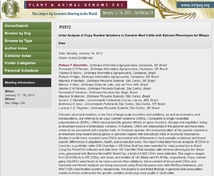Initial analysis of copy number variations in canchim beef cattle with extreme phenotypes for ribeye area.
Initial analysis of copy number variations in canchim beef cattle with extreme phenotypes for ribeye area.
Author(s): GIACHETTO, P. F.; PEREIRA, F. C. P.; MOKRY, F. B.; HIGA, R. H.; MUDADU, M. A.; SILVA, M. V.; NICIURA, S. C. M.; CARDOSO, F. F.; ALENCAR, M. M.; MEIRELLES, S. L. C.; LIMA, A. O.; REGITANO, L. C. A.
Summary: Genomic structural variation, in the form of large-scale insertions and deletions, as well as inversions and translocations, are referred to as copy number variations (CNVs). Compared to single nucleotide polymorphisms (SNPs), CNVs have potentially greater effects on gene structure, dosage and regulation, being an important source of phenotypic variation. In humans, CNVs are widespread in the genome and have been shown to be associated with complex traits. In livestock species, the characterization of this genetic variation is an important step toward linking genes or genomic regions with phenotypic traits of economic importance. Studies in cattle have revealed some CNVs associated with differences in host parasite resistance and breed-specific differences in adaptation, health, and production traits. We report initial data from an analysis of CNVs in Canchim, a synthetic cattle (5/8 Charolais + 3/8 Zebu) that has been selected for meat production in Brazil. Using the PennCNV software and data from 192 Canchim DNA samples with extreme phenotypes for ribeye area, genotyped with Illumina BovineHD BeadChip, a total of 6,985 CNVs were detected. The regions ranged from 20,012bp to 4,157,122bp, with mean and median of 140,484bp and 81,303bp, respectively. Copy number gains (62.09%) were found to be more common than deletions. Gene content of discovered CNVs and functional enrichment analysis are being assessed using Ensembl genes and cattle RefSeq databases, and PANTHER classification system, respectively. We expect to use these findings in genome wide association studies to better understand the genetic variation underlying meat quality in beef cattle.
Publication year: 2013
Types of publication: Abstract in annals or event proceedings
Observation
Some of Embrapa's publications are published as ePub files. To read them, use or download one of the following free software options to your computer or mobile device. Android: Google Play Books; IOS: iBooks; Windows and Linux: Calibre.
Access other publications
Access the Agricultural Research Database (BDPA) to consult Embrapa's full library collection and records.
Visit Embrapa Bookstore to purchase books and other publications sold by Embrapa.

